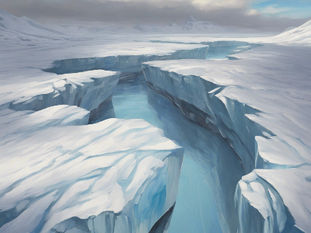
Antarctic Sea Ice Reaches Near-Historic Lows Amid Ongoing Climate Concerns
2 min read
0
1
0
In a striking development, the Antarctic sea ice has reached near-historic lows for the third consecutive year, signaling a potential long-term shift in the Southern Ocean's conditions. This decline, observed in February 2024, underscores the broader impacts of global climate change and raises urgent questions about the future of polar ice.
The Extent of the Decline
On February 20, 2024, Antarctic sea ice reached its minimum extent for the year, marking the second-lowest level ever recorded by satellites. This milestone is part of a worrying trend that scientists at NASA and the National Snow and Ice Data Center have been monitoring closely. Over recent decades, while fluctuations in sea ice coverage have been typical, the persistent decline seen in the past few years is unprecedented.
Causes and Implications
Sea ice acts as a crucial buffer between the ocean and the atmosphere, limiting the exchange of heat and moisture. As ice coverage diminishes, this balance is disrupted, leading to further warming of the polar atmosphere and accelerating the cycle of ice melt. Linette Boisvert, an ice scientist at NASA’s Goddard Space Flight Center, explains that the reduction in sea ice allows the relatively warm ocean to heat the atmosphere, perpetuating a vicious cycle of rising temperatures and melting ice.
This year's significant ice loss is not an isolated incident but part of a broader pattern of change affecting both polar regions. While the Arctic has been experiencing a consistent decline in ice coverage for decades, recent events in Antarctica highlight the global nature of climate change impacts.

Scientific Insights
Recent studies have delved into the mechanisms behind these changes. Researchers from Northumbria University and other institutions have been examining the interactions between ice sheets and oceans. A study on the Pine Island Glacier, a major contributor to sea level rise, revealed that its retreat might have entered an irreversible phase, further stressing the urgency of understanding and mitigating these changes.
Another critical aspect is the observed regime shift in the Antarctic sea ice, indicating fundamental changes in polar climates. This shift, driven by both atmospheric and oceanic factors, suggests that the patterns of sea ice growth and melt are altering in ways not seen before.
Looking Ahead
The continued decline in sea ice has significant implications for global sea levels, weather patterns, and marine ecosystems. As scientists work to unravel the complex interactions driving these changes, it becomes increasingly clear that urgent action is needed to address the underlying causes of climate change.
For enthusiasts and supporters of polar exploration and preservation, these developments underscore the importance of initiatives like those supported by Vintage Antarctica. By fostering awareness and appreciation for the polar regions, we can inspire collective efforts to protect these vital and fragile environments.
Stay tuned to Vintage Antarctica for more updates on the latest research and how we can all contribute to preserving the awe-inspiring legacy of Antarctica.
Sources:
NASA's recent report on Antarctic sea ice levels (NASA).
Research insights from Northumbria University on glacier retreats and climate change impacts (SciTechDaily)(SciTechDaily).
Antarctic Sea Ice Climate Concerns





